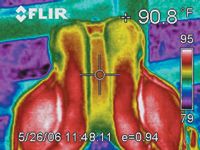Evaluating saddle fit analysis
New developments in saddle analysis can help veterinarians determine if a horse's sore back is due to poor-fitting tack.
Ten years ago dvm360 (then DVM Newsmagazine) published an article called "Saddle Fit" (April 2002), with a 10-step process providing veterinarians and owners a way to objectively evaluate saddle fit. That article was written largely in response to a horse owner's letter that questioned a perceived gap in understanding and attention paid to horses' backs between horse owners and trainers and the equine veterinary community.
It was hoped that having a practical means of saddle fit evaluation would enable more veterinarians and their clients to better determine if a horse's issues were saddle-related or not—and perhaps close the gap between the two groups. The article ended with the statement, "Saddle fit analysis remains a difficult area that is changing rapidly," and the article expressed hope that this topic would be increasingly embraced by equine veterinarians.

PHIL SCHERMEISTER, GETTY IMAGES
Now, a decade later, it would be nice to report that everyone is on the same page. Although more veterinary attention has been turned toward the area of saddle fit, as evidenced by studies investigating the influence of saddle tree width, saddle pad thickness and even individual saddle types,1-3 there still seems to be a disagreement about the actual importance of saddle fit influences on training, behavior and performance.
Additionally, saddle fit analysis itself has become much more complex and technical. The use of thermography and matrix-based tactile surface sensor pads with computer analysis to evaluate saddle fit and equine back problems has made it possible to be more definitive about the exact interaction between horse and saddle. But these modalities have also left the average horse owner just as confused and frustrated as he or she was a decade ago.
How many back problems are saddle-related?
Joyce Harman, DVM, MRCVS, of Harmany Equine Clinic in Virginia, has written an informative and helpful book on saddle fit, The Horse's Pain-Free Back and Saddle-Fit Book, which is widely referenced by many saddle-fit enthusiasts. Harman is a certified acupuncturist and chiropractor and an accomplished saddler with nearly 30 years of equine experience.
Many riders and trainers believe that a large number of training problems are born of incorrectly fitting tack. However, Harman says, "because there are so many variables, it is extremely difficult to put a number on it." Plus, there is a whole industry built up now around saddle design and analyzing saddle fit, so it can be difficult for horse owners to avoid the confusion.
A partial list of the behavioral and training problems that might potentially be saddle-related speaks to the variability and complexity of this issue. Any number of generalized problems can potentially indicate a saddle fit problem, including horses that:
> object to being saddled
> exhibit sensitivity to some forms of grooming, especially along the musculature of the back and flank
> are difficult to shoe
> are unable to stand still
> are "cold-backed" during mounting
> are slow to warm up or relax into a work routine
> are prone to shying or "spooky"
> rush to or from fences
> do not travel straightly
> have poor hind-end muscle development
> do not collect or extend well under saddle
> duck out or turn wide or buck and rear.
However, these same behavioral and training problems can be caused by physiological conditions unrelated to saddle fit.
Still, Harman believes that a large number of horses with behavioral or performance problems are experiencing some type of pain and that a large percentage of that pain is potentially tack-related. Indeed, Harman thinks that nearly 50 percent of poorly performing or behaviorally challenged horses may have a pain-based reason for their actions. Harman backs up this percentage with her own work using pressure sensing pad analysis, and other researchers have also arrived at similar relative percentages.
A study done at New Mexico State University using similar pad sensor analysis evaluated the effect of a rider's weight, the type and brand of saddle, and pad thickness on three areas of saddle fit—spinal process pressure, pressure under the load-bearing bars and bridging or pressure between the front and back of a saddle.4
Of 104 roping saddles, 43 (41 percent) showed excessive pressure (exceeding 3.6 psi), and 93 percent of these ill-fitting saddles had problems occurring in the front of the saddle. Additionally, 73 percent of these horses evidenced sensitivity on the left side, possibly because of the manner in which these horses are generally exercised (counterclockwise loping). Only 28 roping saddles (27 percent) showed spinal process pressure, but 88 (85 percent) showed evidence of bridging.
Barrel racing saddles, on the other hand, showed excessive pressure points in 24 of 49 (49 percent) cases but without the strong left side bias seen in ropers. Spinal process pressure was seen in 16 percent, and bridging was noted in 94 percent.
Overall, problems with some aspect of saddle fit were measured by pad sensor in about 40 percent of the horses, with much higher general numbers for bridging effects.
This same study found that thicker pads increased the probability of a "bad fit" for roping saddles but not for barrel racing saddles. Each additional inch of pad increased the roping horse's probability of a bad fit by more than 23 percent. The lack of such an effect for barrel racing saddles may be due to the smaller sample size for this discipline and due to the fact that few competitors weighed over 150 lb, making pressure on the saddle less dramatic. Each additional pound of rider's weight increased the probability of a bad fitting saddle by 0.5 percent and was most severe when coupled with excessive bridging. Overall, heavier riders tend to try to use more padding for their horses, but the combination of increased weight and thicker padding leads to poorer saddle fit and increased back problems.
Using pad sensor saddle fit analysis
Studies such as these illustrate the value of pressure pad sensor saddle fit analysis and are helping to educate the veterinary community, horse owners and saddle-fit enthusiasts about actual saddle-horse-rider interactions.
"There are many situations where saddle fit has as much to do with the rider as with the saddle," Harman says. "There are some good-fitting saddles and some bad-fitting saddles. There are some good-fitting saddles being used by poor riders that create back problems and some poorly fitting saddles being used by really good riders who keep them from being a problem—and lots of variations in between. A correctly performed and accurately evaluated saddle fit analysis is an excellent way to make sense of all these interactions."
As with any computer analysis, though, it is still a matter of "garbage in, garbage out." The care and thoroughness of a pressure pad saddle analysis is crucial to the overall value of the evaluation, and the skill of the practitioner is paramount. Harman advises that a good-quality saddle fit analysis should take well over an hour and should include palpation of the horse and saddle, static and moving evaluation of the saddle and related areas and then pressure point analysis. Because marked variation exists between different pad sensor systems, there will be variation in analysis as well. The number of sensors per pad, the sensitivity of those sensors and their ability to detect variations in pressure, especially at lower ranges, determine the quality of the pad. "The better quality the pad, the more accurate information yielded by the evaluation," Harman says.
Using thermography
Technical skill is crucial in the use of thermography to evaluate saddle fit and possible medical conditions in horses. Thermography, or the use of infrared imaging, allows a real-time evaluation of the temperature gradient in the peripheral body (Photos 1 and 2). Areas of increased heat can indicate metabolic activity, increased blood supply or the possibility of an inflammatory process. Decreased heat can indicate vascular damage or nerve involvement. Saddles are excellent heat conductors and allow visualization of the contact points after only a relatively short amount of time being ridden.

Photo 1: In a thermography scan of a saddle, the color scale goes from black (coldest and least contact, pressure or heat) to white (hottest and most contact or pressure). This rider has a chronic right knee problem and cannot ride in a balanced way. He puts more weight on the right side because he cannot post out of the saddle with that knee, which twists the saddle so you see increased heat on the entire right side. This horse had a sore back and was sore in his right girth and chest area.
Because there is such a potential for artifacts to be seen while producing thermographic evaluations and for mistakes to be made in interpretation, it is crucial that a knowledgeable and experienced individual produce and evaluate the scans. Thermography has the advantage of producing both pre- and post-exercise scans, which can show a substantial change in affected areas.

Photo 2: This thermography scan shows a saddle with increased contact, pressure and heat on the withers area and hardly any contact on the back of the saddle. This is an example of a bridging problem-as this saddle rocks back and forth, it will pinch the withers and shorten stride and cause soreness. Occasionally these horses are presented for evaluation of a complaint of increased tripping in front.
Conclusion
As more veterinarians add newer modalities such as thermographic imaging and pressure pad sensor gait analysis to their practices, it will become easier to determine the location and exact cause of various medical conditions or to decide that it is indeed time to go saddle shopping. When this topic is revisited in the future, maybe there will be more agreement among horse owners, saddle fitters and veterinarians as to the effects of saddle fit on equine performance and behavior. As all parties become more aware and educated, we can hope that better choices will be made for saddle fit and the percentage of horses being ridden while in pain can be drastically reduced.
Dr. Kenneth Marcella is an equine practitioner in Canton, Ga.
References
1. Clayton HM, Kaiser LJ, Nauwelaerts S. Pressure on the horse's withers with three styles of blanket. Vet J 2010;184(1):52-55.
2. Harman JC. Practical use of a computerized saddle pressure measuring device to determine the effects of saddle pads on the horse's back. J Equine Vet Sci 1994;14,606-611.
3. Meschan EM, Peham C, Schobesberger H, et al. The influence of the width of the saddle tree on the forces and the pressure distribution under the saddle. Vet J 2007;173:578-584.
4. Cockerman S. Saddle fit study in the Western saddle market. Las Cruces: New Mexico State University Press, 2010.